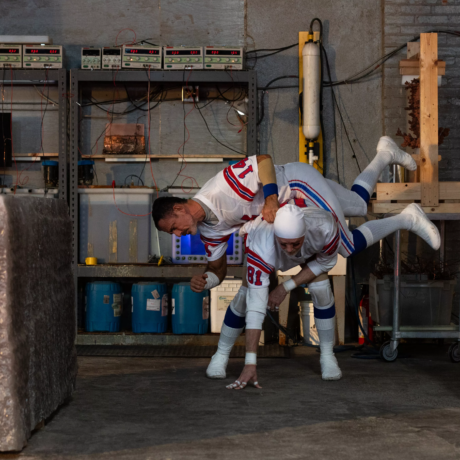
A young woman runs through a sun-strewn grove, her indigo dress swaying with each and every step. Expectation glistens in her eyes, the blue from her dress shining amber in the half-morning light. She is holding something in her hands, something precious, something unrefined. She reaches her companion in the depths of the woods, his feet making furrows in the untilled ground. She opens her hands, reveals and frees their contents before him. ‘Shad, how can we plant with this dust?’ She asks her husband. ‘We plant ‘em each and every year or we’re finished,’ he replies, watching the copper soil slip from her palms.
This memory belongs to Nana Peazant, the matriarch of the eponymously named family in Julie Dash’s acclaimed feature film, Daughters of the Dust (1991). Embraced by two younger generations of her clan, Nana is overcome with a sense of the past, with a recollection as vital to her life story as it is to the stories of those around her. The dust to which her memory returns is that of Ibo Landing, a legendary and now historically recognised site on St Simons Island, off the southern coast of Georgia, America. Nana’s flashback may not recover the exact details of the first landing – of the captive West African peoples who, upon first seeing the land, resisted the fate of slavery by choosing death in the water – but her remembrance of the dust, of its infertility and the island’s inhospitable conditions as espied in the near-barren earth, reflect what her ancestors saw before her. That a young Nana succeeded in cultivating the poor terrain of St Simons Island is testimony to her determination to live and build beyond her former enslaved state, to create a dynasty who would not only freely live on this same land but own it long after her death. Embracing her granddaughter and great-granddaughter, Nana’s wild hope has been fulfilled, her planting of new life grown beyond her initial expectation.
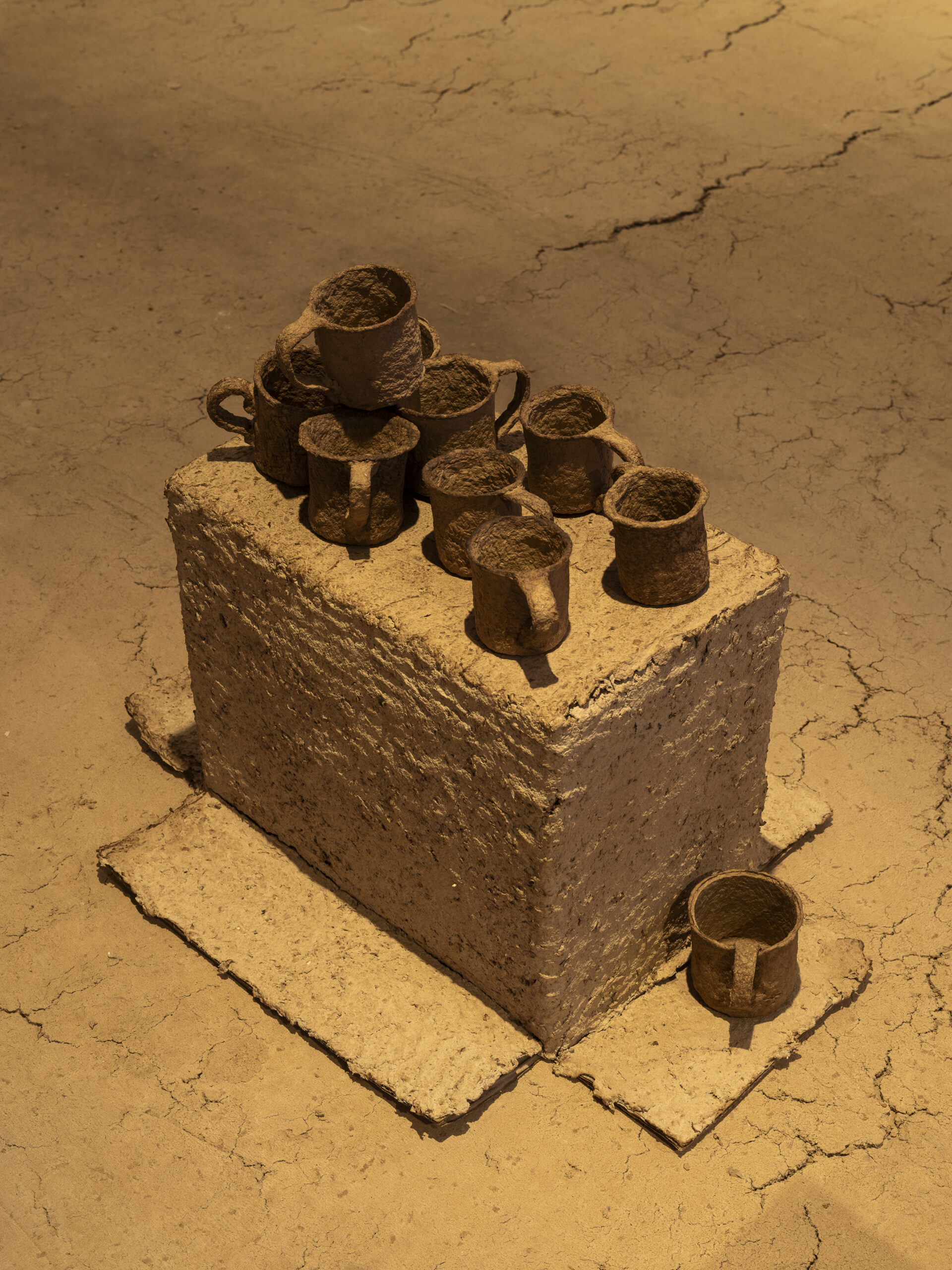
For all its many references to water, Dash’s Daughters of the Dust is a film rooted in the earth. The children may play on a golden windswept beach, restless to migrate to the North, but Nana Peazant sits and squats in that same ‘dusty’ earth towards which her mind continually turns. All day she clears the bracken and brambles from the graves of her deceased kin, and sits in a wicker chair in a similar wilderness reflecting on ancestral knowledge about herbs, plants and roots. Never seen without her tin of ‘memories’, ‘dusty ‘tings’ as her great-granddaughter Eula terms them, Nana Peazant ruminates on the gifts and curses of the land upon which she was born and to which she will soon die. But her dust-coated and earth-bound memories are not solely about Ibo Landing. Unlike some of her children, Nana knows that the soil of this island contains the buried secrets of former lands and the unwatered seeds of the next. Working the land, protecting and nurturing what is left of it, Nana Peazant protects and nurtures the memory of those from afar – the first Igbo peoples to arrive on the island – as well as the vision of a future generation of Gullah women – a community that still lives on the island to this day.
Daughters of the Dust narrates then an odyssey of the land. It presents a mythical as well as historical account of what the earth was and could be for the most marginalised peoples. A source of brutal oppression for those subjugated to the violence of slavery (like Nana and her ancestors), it becomes in turn a basis upon which to seek and secure liberation, a record of human destruction as well as reconstruction. Dash’s film, though specific to the heritage of the women of the Gullah community (from whom she too directly descends), and more broadly speaking, all African Americans, plants in its own poetic and fertile soils metaphors and themes for women artists working with soil-based and natural materials today. In its collapsing of past and future, memory and premonition, home and exile, stasis and movement, oppression and liberation, hurt and healing, body and soul, Daughters of the Dust tills the rich plains of collective afro-centric ideas and ideals, and in doing so offers contemporary artists firm ground upon which to sow their own. From the wise and indigo-dyed hands of Nana Peazant, seemingly ‘dusty’ concerns regarding ecology, geology, economy, climatology, historiography and psycho-geography, indigenous and diasporic epistemologies, decolonial and ecofeminist thought slip into the minds of viewers and artists today. In replanting a sense of selfhood, purpose and futurity in the sterile soil of colonisation and slavery, Nana demonstrates the power of women, specifically Black women, in the cultivation of their own liberation, as well as the importance of land, particularly its ‘dust’, in the narration of our own human story. Artists like Dineo Seshee Raisibe Bopape, Otobong Nkanga, Sandra Poulson and Hayv Kahraman recapture something of Nana’s complex relationship to the soil in their own works, unearthing her concerns, as well as their own histories, realities and beliefs of how we should and could relate to the land. In placing natural materials in unnatural settings like galleries and museum, these artists recognise the ‘sweat of love…in soil’, as Nana recalls, and brilliantly subvert what it means to be ‘daughters of the dust’.

The material of dust is potently and subversively present in the work of Dineo Seshee Raisibe Bopape. Interested in ideas of collective memory and the unconscious, the maternal body and its connection to mother earth, Bopape espouses Nana Peazant’s soil-enriched and enabled mode of being, and echoes her empowering ecofeminist faith in ancestral and spiritual ties to the natural world. In fact, Bopape’s latest work mines Nana Peazant’s – or rather Dash’s – Afrofuturist vision of the soil encompassing past, present and future potentialities, ecologies and ontologies, thus rendering dust a means as well as a valued living material in and of itself. Taking her cue from Dash and cinematographer Arthur Jaffa, whose lush poetic visuals frame these themes beautifully in Daughters, Bopape creates a dreamscape and an environment in which we too can dream. (ka) pheko ye – the dream to come, currently on show at the Kiasma, Finland, features multiple domed enclosures made of soil and peat arranged in a near circular formation amongst other clay structures and miniature figures and forms. Though Bopape references and works with the wintry Finnish light and has floral and herbal scents flowing through the whole installation, it is the unvarnished stuff of the earth, the soil and clay, that here takes pride of place. Upon first glance, the artist’s soil-orientated space resembles a geological site, one increasingly being unearthed as well as made of it. Blocks of compacted earth sit cordoned off, whilst a clay painted border surrounds – effectively embraces – the entire gallery circumference. As a kind of archaeology or recreation of an excavation, Bopape touches on Afrofuturist and decolonial notions of undiscovered worlds, alternative geographies and ulterior cartographies slowly coming into being. Yet for all its speculativism and apparitional atmosphere, the soil-based environment of (ka) pheko ye – the dream to come is one to inhabit and touch. Though a site of the imagination, it invites us to dwell and commune, play in and dream with the material language of the earth inside the gallery and then outside of it.

Bopape’s domed enclosures also convey a sense of home in the unhomely. Reminiscent of the original soil-enforced dwellings of the Sami people, Finland’s indigenous communities, Bopape’s structures simultaneously look to the round huts of South Africa and other traditional constructions from the artist’s homeland. In a land of unfamiliarity, Bopape reworks the soil into one of familiarity. This diasporic tendency to reconfigure what is foreign and hostile into something homely and safe, takes us back to the young Nana Peazant’s fear over the infertile soil of Ibo Landing, and, therefore, her fear of surviving the violence of the terrain itself. It takes us right into the paradox of dust being a force of death and life at once. It takes us back to those forced into close proximity with the earth and whose fates are closely commingled with it. When discussing the migration of African American artists to Western states of the US in the 60s and 70s, Kellie Jones reflects on exactly this conflicting and ‘uneasy’ state concerning space. For Jones, Black migrants at this time renegotiated the social and natural spaces in which they found themselves. Bringing with them knowledge and skills from the South – and by extension knowledge and skills learnt from their West African ancestors – Black migrants reclaimed and remade the ‘terrain’ in their own image. This sense of space, for Jones by way of Katherine McKittrick and Jasmine Griffin, is as much physic and ancestral, as it is physical; it is ‘the home one carries within’. Likewise, out of the discomfort of being in another land, using other materials, Bopape creates constructions that are as comforting to view as they are comfortable to inhabit. The notion of home is carried within, but replicated without by way of soil available to the artist in that specific country. Bringing together diverse technologies, mediums and epistemologies (Finnish habitudes of dwelling and climate with South African ones), Bopape creates a cross-cultural and inclusive space sustained through and anchored by the diasporic logic of the soil.
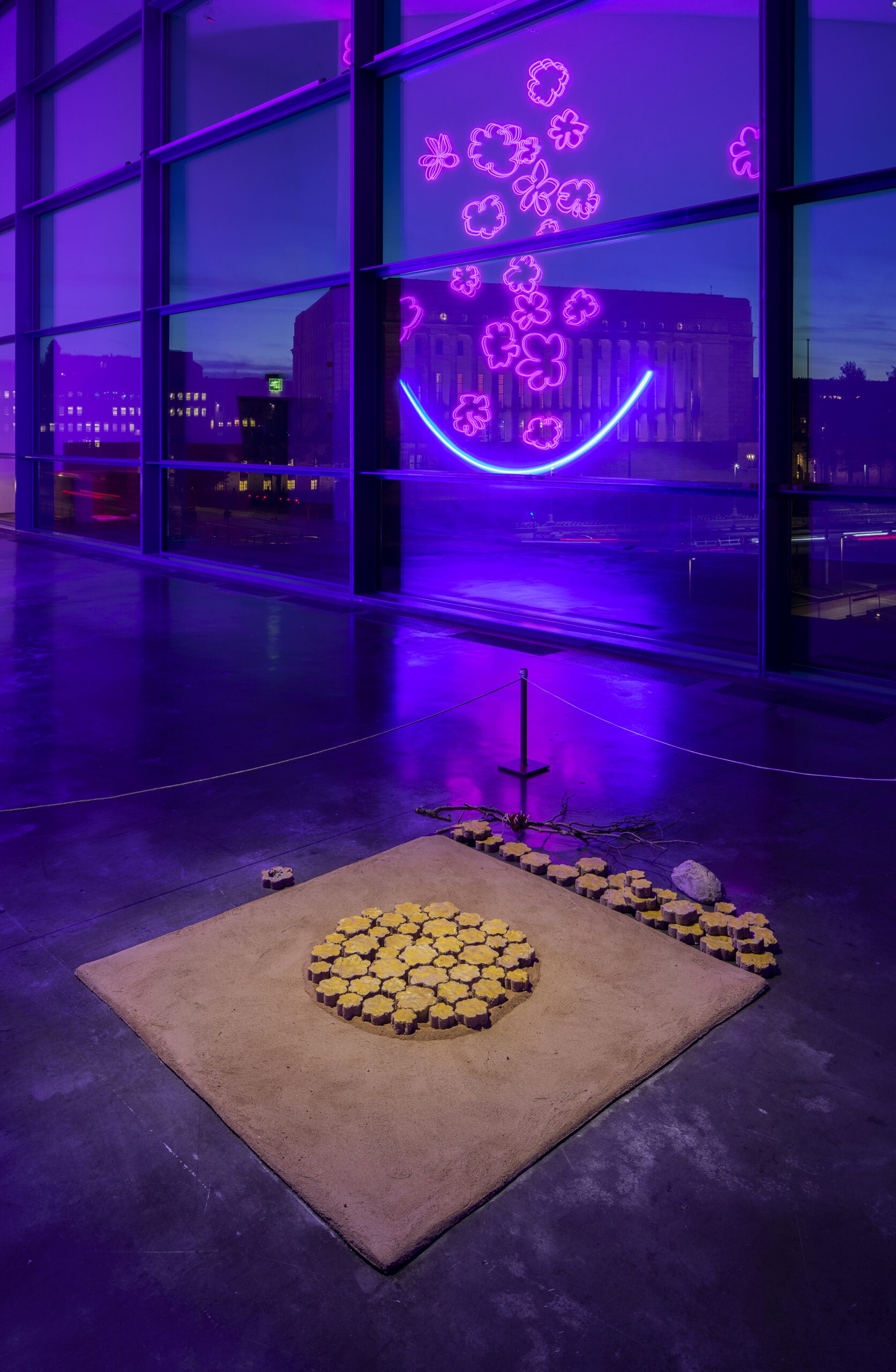
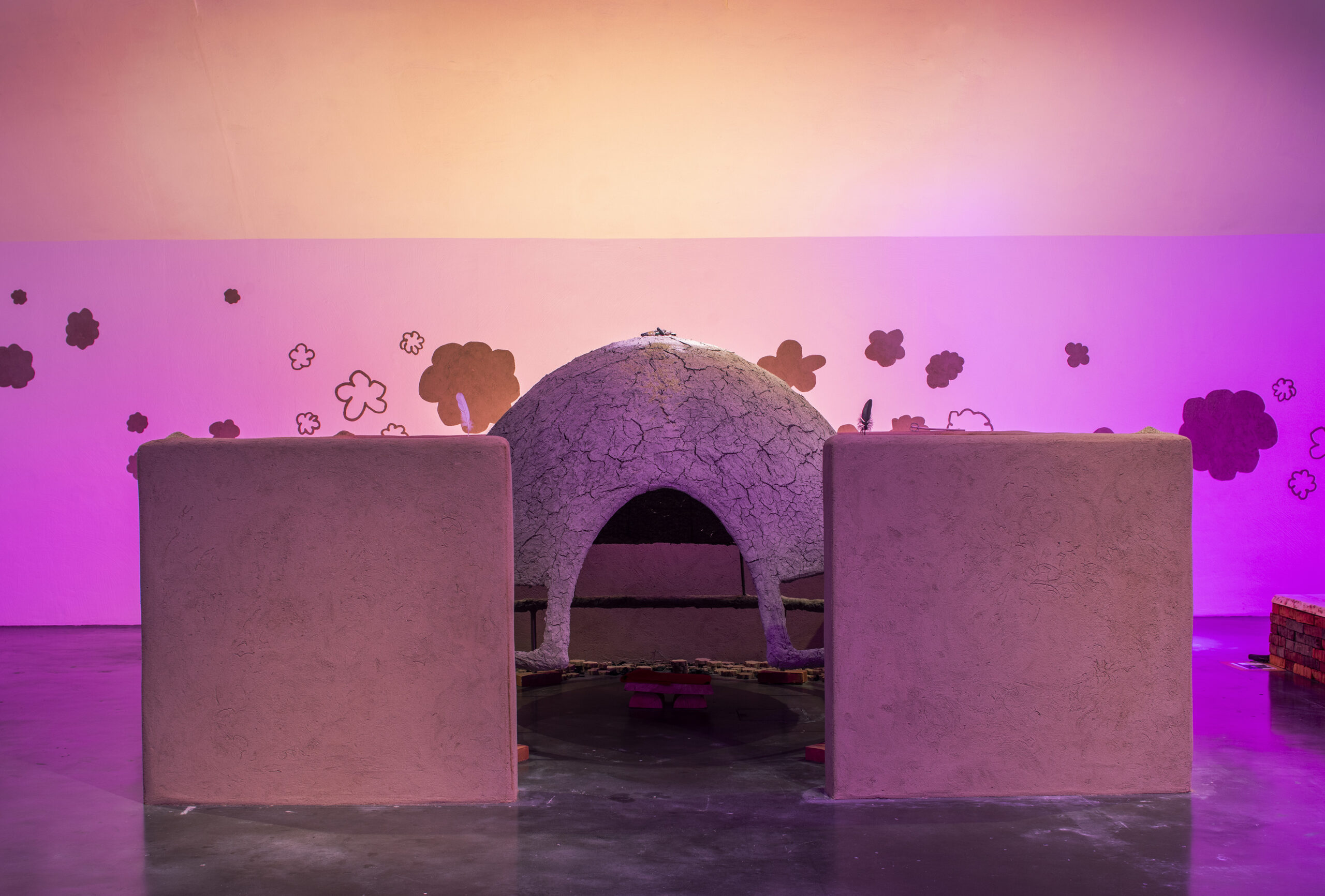
This exchange between worlds – between their geopolitical, ecological, environmental and cultural knowledge systems and the materials in which they are embedded – takes us backwards as well as forwards in time and place. Despite making soil-based and clay environments that traverse these limitations, Bopape’s installation still incorporates and registers them. Finland’s historic treatment of migrating bodies and the homelands of Sami peoples, alongside South Africa’s own continued narrative surrounding colonial and neo-colonial violence, occupation, land reform and restitution towards Black African peoples, miners and farmers, are all indirectly enmeshed in Bopape’s dreamy invitation to sit and dwell together amongst the earth. But can we, in actuality, sit and dwell together, when some bodies and the land they have a historic right to own are denied and torn asunder? It is here, again, that Nana Peazant’s Afrofuturistic ethos of acknowledging the past and present trouble in order to move forward in the future comes to mind. Naturally Bopape’s work is one of delay and deferral, a dream that can be partially envisioned, but is yet ‘to come’, as the exhibition title so poignantly states, beyond the confines of the gallery. Sitting amongst the fabric of the earth, what dreams can we make a reality? What lives and bodies come sharply into view when we reflect on this here soil and the stories long buried within it?

Otobong Nkanga’s multimedia and interdisciplinary work, Solid Maneuvers II (2015), also brings to light the bodily realities of indigenous African peoples in relation to their own land. Performing at the centre of a sculpted replica of geological strata, specifically Namibia’s Green Hill which has seen its mineral-rich soil plundered and hollowed out, Nkanga highlights the devastating effects of corporate greed on humans and nature alike. Mirroring her own drawings, which also have life-size human figures towering over miniaturised natural plains and green topographies, Nkanga’s performance draws the human reality of excavation and mining out of the two-dimensional realm of the imagination in order to underscore the cost of illegal mining and land extraction. Recounting the life and death, aspirations and painful realisations of a former miner, Nkanga demonstrates, through her own words and bodily manoeuvres, the connections between and intersecting repercussions for Namibian bodies, Namibian land and our own. For it is the minerals (chiefly vermiculite) recovered from the bowels of the earth that end up in the make-up of western consumers, and it is these same rare materials that cause grievous illnesses and diseases for the miners and surrounding communities. Throwing out the raw matter of the earth in front of a western audience, Nkanga literalises the waste and wreckage we wreak on the planet and on those bodies who attempt to tend or mine it. Solid Maneuvers II, whose title emphasises the actions of human hands and the manual labour of disenfranchised communities, is not, in its layered interaction between global realities and socio-economic structures, so solid after all. Like the minerals that Nkanga ritualistically and ominously disperses before the viewer, the lands and bodies of its people will not hold if we continue to pillage natural resources for vain and capitalistic gain.
Nkanga’s performance recalls the still of the young Nana Peazant’s dust-covered hands as a metaphor for the inhospitable living conditions she endured. Unlike Nkanga, whose exploration of earthen environments comes as a warning to western corporations and consumers, Dash’s close-up of the bronze-tinged dust upon Nana’s hands is a reversal of this narrative and testifies as much to the ingenuity of Black women as it does to the acute adversity they suffered, particularly during the eras of pre-war slavery and reconstruction. Nana Pezant’s dust covered, indigo-stained hands, that is her intimate interconnection to the land and her enforced labour of it, echoes Katherine McKittrick’s observation that Black women are ‘both shaped by, and challenge traditional geographical arrangements.’ Left little than dust to cultivate, treated worse than the dust crusted upon her hands, traditional geographical and socio-economic arrangements of the land have rendered Nana, like the miners in Nkanga’s installation, as less than the dirt upon which she stands. And yet, Nana challenges this dominant geography and economy, generating crops from dust, life from the death often allotted to the enslaved state. Surrounded by her own reconstruction of the scarred and ravaged plains of Namibia, Nkanga, the human form scattering mineral-rich dust like birdseed before us, hints at the possible geographical outcomes and lives to salvage if we reversed the deadly actions our own hands indirectly inflict upon distant lands.

Again the dualistic symbolism and properties of dust are examined in Sandra Poulson’s mixed-media installation, Dust as an Accidental Gift (2023). Originally shown at the Sharjah Architecture Triennial, Poulson’s daring work privileges dust, specifically that which Angolan peoples situated in the urban area of Luanda experience. Here dust as social marker, political divider and economic deciding factor are all explored and exploded. Featuring a clay-covered interior populated with dust-coated objects, furniture, clothing, implements and apparatus, Dust as an Accidental Gift revels in the potentiality as well as the paucity that dust from the inner Angolan landscape brings forth. Clay coloured sculptures of trousers, dresses, shoes and coats figure the absent human inhabitants who have been subject to this arrant colonially enforced yet climatically formed condition. In line with Nana Peazant’s dust-clad hands and McKittrick’s theories, the prevalent presence and power of dust for the indigenous Angolan inhabitants both shapes and is challenged by them. Although dust distinguishes wealthier white Portuguese settlers from indigenous Black Angolans, the latter of whom were pushed into ‘forming informal neighbourhoods ‘paved by dust’’, it also brings economic advantages through the activities and types of labour organised around its eradication. Dust, therefore, presents a new geography and a new opportunity for native Angolans to thrive, not just survive, the ever palpable hostilities and pervasive atrocities of colonialism.
Poulson’s work then, much like Bopape’s enclosures and Dash’s poetic envisioning of Ibo Landing before them, indirectly shares with what McKittrick defines as a ‘black sense of place’. When examining the algorithms predicated upon and employed to predict those vulnerable to violence, McKittrick pauses to acknowledge that various technologies and geographies are posited on the deaths of Black individuals, rather than accounting for and positing their lives. Though in part calling for an excavation of data not land per se, McKittrick sees how this algorithmic violence is located in and also maps out traditional colonial cartographies. However, in response, McKittrick asserts that a ‘black sense of place’, though ‘born of plantation slavery’ and colonial endeavour, cannot be ‘contained by the logics of white supremacy’. (That is, no algorithmically contrived map will ever truly capture the lived geographies of Black lives). Likewise, the dusty terrain, though it threatens death and drudgery, can also be the prospect and point of life, the ‘accidental gift’ in a Black sense of place and time, as well as a promise to Black and brown lives of ‘the dream to come’. What is more, a ‘black sense of place’ is a ‘location of difficult encounter and relationality’ (think Bopape’s cross-cultural earthen enclosures, Nkanga’s intersecting worlds through mining soil, Poulson’s dust-coated urban inland of Luanda, Dash’s infertile Ibo Landing) and ‘a collaborative praxis’, where renegotiation between former modes of being and newer ones occurs. Diasporic, decolonial and (anti-)plantocratic in nature, a ‘black sense of place’ in these dust-centric works, courts new exchanges and fosters new communities whilst honouring the histories of older ones.
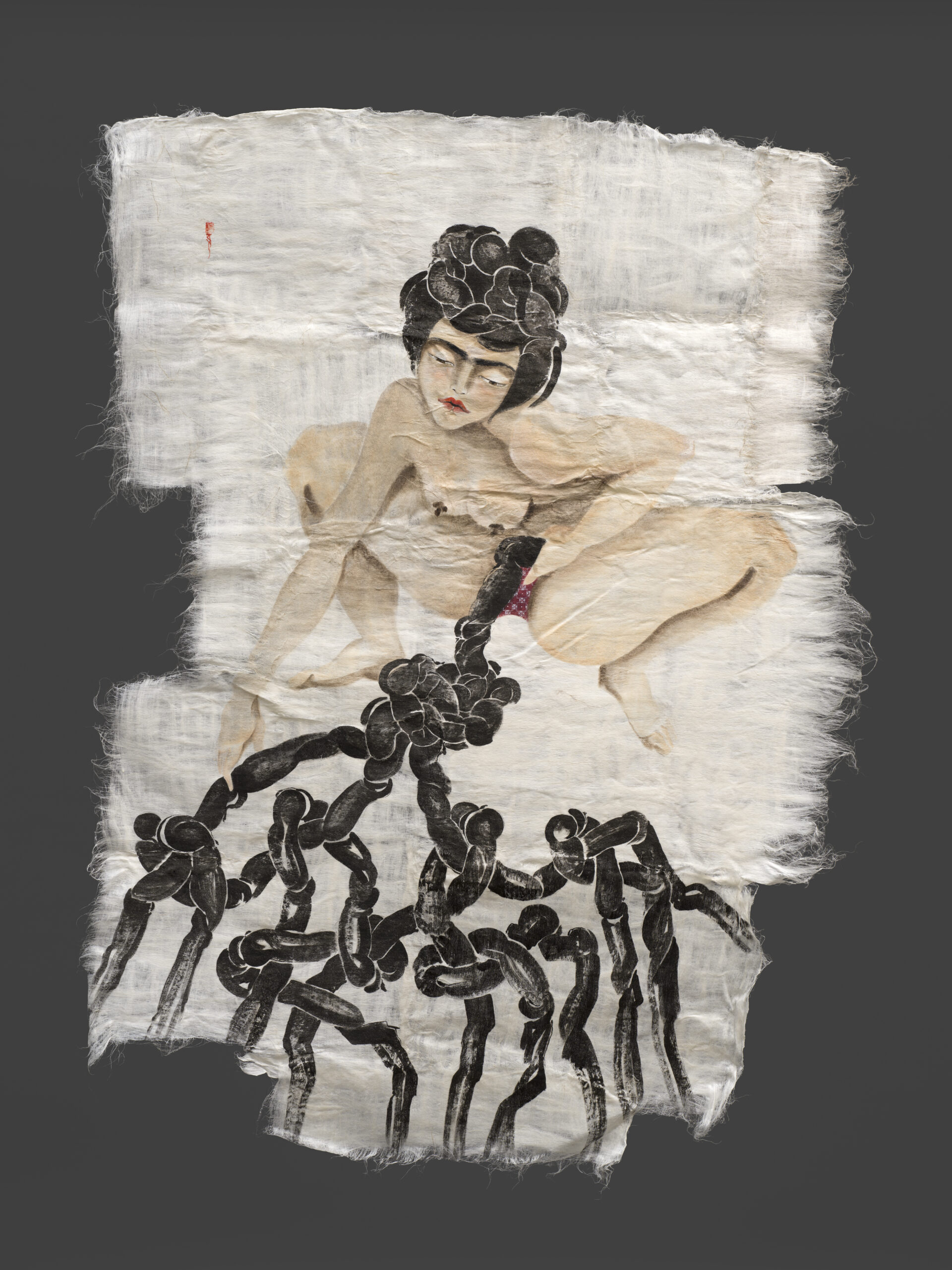
Hayv Kahraman’s work speaks into this ‘black sense of place’ in its engagement with soil and the trauma of women of colour. Though soil-based material or dust is not explicitly visible in Kahraman’s art, it is implicit in the seams and threads of her drawings which are created on flax. Harvested by bacteria in the soil, the flax becomes another source of creativity – as well as the produce of it – an alive surface cultivated from the live cultures of our microbe-enriched earth. Evidently a source of ingenuity in and of itself, the body of the flax then holds different kinds of bodies and cultures, ones too often othered and equated with dirt. Far from seeing the soil-soaked and reconstituted flax as an abject item, Kahraman sees the effectively “dirtied” material as a surface upon which to map out healing and a creative dimension in which subordinated and oppressed bodies can be. In Entanglements and Generations (2022), a long rectangular ink drawing on flax, three women squat amongst a thick tangled intestinal cord. Black like the soil from which the flax has been soaked, the cord at once resembles rope, chains, netting and the aforementioned duodenum-like innards of the body. The women, whose naked torsos and limbs are caught up in this sinister cord, descend downwards as if traversing the digestive or neurological systems of their own bodies. Inspired by ‘neurosculpting’ and neuropsychology that sees the gut as integral to the health and healing of the mind and the rewiring of neural pathways, Kahraman’s drawings, in particular Entanglements and Generations, both literalises and narrates this process of renewal through both the human gut and the bowels of the earth. As hinted in the title, the women in Kahraman’s drawing revisit and grapple with their traumatic neural entanglements only to regenerate (perhaps even replicate?) and heal. In this light, the cord in Entanglements and Generations is re-envisaged into an umbilical thread and linkage gesturing towards a rebirth. In the fabric of the flax and in the composition of the drawing, a rejuvenating form of embodiment that comes from the body of mother earth is presented. In this subversion of abjection – the aggrandisement of the gut, the body, the dirt from which all has sprung and will eventually disintegrate into again – Kahraman moves the language of earth and the soil-soaked flax into the realm of McKittrick’s ‘black sense of place’. By celebrating and actively nourishing alternative knowledge systems and reclaiming colonised terrain and the bodies that work it, Kahraman’s gutsy and gut-orientated drawings become ‘locations of difficulty and relationality’, ones that reorient us in the embodied difficulty and relationality that they depict. From the beautifully soiled flax these women sit with the trouble and navigate a way forward in the brilliant muddy mess of it all.
From Nana Peazant’s hands through to the hand-drawn “dirtied” drawings of Hayv Kahraman, these artists have placed our endangered earth and its most precious resource, soil, at the centre of their works in order to illuminate the most marginalised lives who are tethered to it. Decolonial and ecofeminist in practise, many of the women artists explored above go back to the dust not just out of fear of what it contains – the long lost histories it holds and withholds – but because of what it foretells and could make possible. For the deferred dreams and delayed temporalities, alternative geographies and unwritten cartographies that could, with the care of current generations, be realised now, not least for the future daughters of the dust.
Written by Hannah Hutchings-Georgiou

